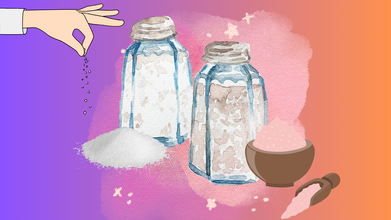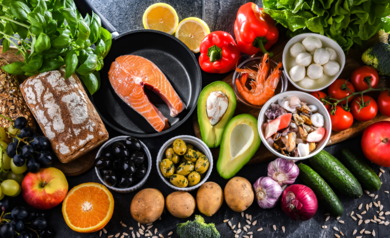- Health Conditions A-Z
- Health & Wellness
- Nutrition
- Fitness
- Health News
- Ayurveda
- Videos
- Medicine A-Z
- Parenting
- Web Stories
Prediabetic Patients Found To Benefit From A Cup Of Beans Everyday: Study

(Credit-Canva)
Known as the best source of fiber and essential vitamins and minerals, beans are the best plant-based protein options one can opt for. Used all over the world, these versatile seeds are prepared in many different ways, whether it is in burrito bowls or in Rajma curries. However, did you know that these beans are far from just a delicious addition to our diet? They could also help us avoid diabetes and high cholesterol as well as inflammation.
Beans are far more than just a simple food; a recent study reveals they hold surprising health benefits, especially for those at risk of type 2 diabetes. Eating just one cup of beans daily significantly improved the health markers in a small group of people with prediabetes, a condition where blood sugar levels are elevated and close to developing into full-blown type 2 diabetes.
How Beans Helped Our Health
Presented at the American Society for Nutrition in Orlando, the study found that beans reduced inflammation in the body. Think of inflammation as a constant, low-level irritation inside you that can contribute to serious health problems. Even though bean consumption didn't directly change blood sugar levels in this particular study, these other benefits are a huge deal because people with prediabetes often have high cholesterol and inflammation, both of which increase their risk for other long-term health issues like heart disease. So, beans can act like a protective shield for your body.
What Did The Study Find?
In this study, 72 people participated for 12 weeks. They were split into groups, with some eating black beans, others eating chickpeas, and a control group eating rice. The results were pretty clear:
- Chickpeas were especially good at bringing down overall cholesterol levels.
- Black beans were effective at reducing signs of inflammation in the blood.
Basically, the study showed that beans are not just good for people with prediabetes, but they're a fantastic choice for everyone looking to improve their health. These findings could even help shape what doctors and public health programs tell us about preventing heart disease and diabetes.
Easily Add Beans to Your Meals
The good news is that it's quite simple to swap out less healthy ingredients for beans in your everyday cooking. Just be careful to check labels for added sugars or too much salt when buying canned beans.
The researchers are now looking into how eating beans might affect your gut health, which is another exciting area of study.
Beans are a budget-friendly way to boost your overall health and reduce your risk of long-term diseases. Try blending them to make soups thicker, tossing them on top of your salad for extra protein, or pairing them with grains like rice or quinoa.
Soups and Stews
This is one of the easiest ways! Just toss in a can of rinsed black beans, kidney beans, cannellini beans, or chickpeas into almost any soup, chili, or stew during the last 10-15 minutes of cooking.
Pasta Dishes
Stir a can of drained and rinsed white beans (like cannellini or great northern) into your pasta sauce. They'll blend in and make your meal heartier and more nutritious. You can also add them whole to pasta salads.
Tacos, Burritos, and Quesadillas
Beans are a natural fit here! Mash them up for a refried bean base, or add whole black beans or pinto beans to your fillings. They're excellent in breakfast burritos too.
Salads
Boost any salad by adding a handful of chickpeas, black beans, or kidney beans. They provide a nice texture and make the salad more filling.
Rice Dishes
Mix beans into your rice. Classic rice and beans is a complete and satisfying meal, but you can also add them to stir-fries or grain bowls
Creatine: Bodybuilder's Favorite Supplement Is Now Becoming Workaholics' Go-To

Credits: Canva
Creatine, long hailed in bodybuilding circles as a must-have for muscle strength and growth, is now making waves far beyond the gym. Social media influencers, health podcasters, and even physicians are touting its potential benefits for brain health, hormonal balance, and healthy aging—prompting busy professionals and workaholics to take notice.
But while research strongly supports creatine’s athletic benefits, evidence for its wider applications remains mixed. Here’s what science says.
What Exactly Is Creatine?
Creatine is a naturally occurring compound produced in the kidneys and liver from amino acids. It fuels short, explosive movements by rapidly recycling energy in muscles. Around 95% of the body’s creatine is stored in skeletal muscle, with the rest in the brain, liver, kidneys, and heart.
Our body produce about one gram of creatine daily, while the rest must come from diet. Meat and fish are the richest sources, 225 grams of beef or salmon can provide up to 2.5 grams. This makes supplementation particularly beneficial for vegetarians, who often have lower baseline creatine levels.
Experts suggest three to five grams daily to maintain optimal muscle stores.
Proven Benefits in the Gym
Creatine’s reputation was cemented in 1992 when a landmark study confirmed that supplementation with creatine monohydrate boosts muscle creatine without harmful side effects. Since then, hundreds of studies have shown it helps athletes perform better and recover faster.
By extending the body’s energy system during high-intensity efforts, creatine allows athletes to push harder—whether it’s sprinting, lifting heavy weights, or powering through explosive moves.
A 2024 meta-analysis found that adults under 50 who combined creatine with resistance training gained significantly more strength than those who only trained. On average, lifters on creatine added an extra 4.4 kg to upper-body lifts and 11.3 kg to lower-body lifts.
However, most of these benefits were observed in men, with research in women still limited.
Brain Health and Beyond: Hype or Hope?
The new surge in interest stems from claims that creatine supports cognitive function and women’s health.
A 2003 clinical trial suggested creatine improved working memory and processing speed, sparking speculation that it could benefit older adults or those with demanding mental workloads. More recent reviews, including one in Frontiers in Nutrition, published in 2023, found moderate evidence of improved memory and faster information processing, though no significant improvements in overall accuracy.
Women’s health is another frontier. Some studies hint that creatine could help during pregnancy or menopause, when hormonal fluctuations affect energy metabolism. A review in the Journal of the International Society of Sports Nutrition linked low dietary creatine intake with higher risks of menstrual irregularities and pelvic disorders. Still, experts caution that most findings come from small or association studies, not large-scale clinical trials.
The supplement is also being explored for its role in blood sugar regulation and type 2 diabetes, but current evidence remains speculative.
How to Take It Safely
The Australian Institute of Sport recommends sticking to creatine monohydrate, the form backed by 99% of research. It is widely available, affordable, and easy to mix into water or shakes.
Most evidence supports a daily dose of three to five grams, which saturates muscle stores after about four weeks. For faster results, some use a “loading phase” of 20 grams daily for five days, followed by maintenance dosing.
While higher short-term doses may be needed for potential brain benefits, the optimal amount for cognitive support remains unclear.
Side Effects and Risks
Creatine is generally considered safe, with few reported side effects. Some users may experience stomach upset or water retention, particularly with large doses.
Concerns about kidney or liver damage have been largely debunked in healthy individuals. That said, experts recommend buying from trusted brands to avoid poor-quality supplements that could increase digestive issues.
Interestingly, up to 30% of people may see no noticeable benefits from creatine supplementation at all—a reminder that individual response varies.
Creatine’s transformation from a muscle-builder’s secret weapon to a potential “workaholic supplement” highlights how quickly wellness trends spread in the age of social media. While its benefits for athletic performance are firmly established, claims about brain health, hormonal balance, and blood sugar support remain promising but unproven.
Pink Salt vs White Salt: What Difference Does It Make?

Credits: Canva
The pink salt trick recipe for weight loss has been recently debunked, with Health and Me, bringing out the myths that surround around the viral recipe. The TikTok-viral recipe claimed that this was a "shortcut to fat loss and metabolic reset". However, most of the videos circulated as its advertisement were either fake claims or have been made using AI or deepfake videos of celebrities who have never actually used it. Experts too have pointed out that this drink may cause harm due to its high sodium intake, which could lead to bloating than fat reduction. Others have also pointed out that the lack of iodine in pink salt could lead to thyroid disruption if it is consumed daily and substituted for the regular table salt.
Read: Harvard Gut Doctor Dispels Basil Seeds Myths You Probably Believed
Pink Salt vs Table Salt: Nutritional Comparison
Pink salt is mostly sodium chloride, like the regular table salt, however, it contains trace minerals like potassium, magnesium, and iron oxide, which gives it a pink hue. However, Dara Ford, PhD, RD, program director of the Master of Science in Nutrition Education at American University tells verywellhealth that it can increase thirst, like any other salts do. She also noted, "The presence of additional trace minerals is varied at best and does not provide more nutrients than a balanced, healthy diet."
While 'Pink Salt' is a catch-all term with its Himalayan minerals, it does not really provide the mineral it claims, but the pink hue and the claim that it is mineral-rich is what makes it commercially attractive.
Where Does Pink Salt Come From?
Pink Salt is also known as Khewra salt because it comes from Pakistan's Khewra Salt Mine, which does have trace of minerals. However, the amounts are too small to make a real difference. To equalize the benefits, one has to consume a large amount of pink salt to actually notice the benefits, which means a large amount of sodium chloride too is entering your body. This means that you might be putting yourself at risk of high blood pressure, heart disease, stroke, liver damage, osteoporosis, and kidney diseases.
By replacing regular table salt, which is fortified with iodine, one puts their health at risk.
Also Read: Pink Salt Vs White Salt, Which One Is Better?
Since pink salt is not iodized, your iodine intake may fall and cause you iodine deficiency and thyroid issues. Whereas the iodine in white salt is important for thyroid function and the consumption is enough to protect against any iodine deficiency. Individuals are only supposed to consume 1,500 mg of sodium per day while consuming salt.
What Happens In Iodine Deficiency?
- Hypothyroidism: a condition that is accompanied by goitre, as it is one of the earliest signs
- In pregnant women, it can cause neurodevelopmental deficits and growth retardation in the fetus, miscarriage or a stillbirth
- Cretinism: a condition characterized by intellectual disability, deaf mutism, motor spasticity, stunted growth, delayed sexual maturation and other physical or neurological abnormalities
- Neurodevelopmental deficits in infants can cause them to have lower-than-average intelligence as measured by IQ
- Attention deficit hyperactivity disorder in children
- Impaired mental function and work productivity secondary to hypothyroidism
- Increased risk of follicular form of thyroid cancer
Read: Why Is Iodine Important For Us?
Pink salt also typically contains less sodium. This is causing hyponatremia, a condition caused due to sodium deficiency. Research suggests that nearly 70% of individuals over sixty may be affected, yet awareness remains low. With the youth shifting to low-sodium alternatives like pink salt or Himalayan salt, the risk of low sodium is high.
Even With Alzheimer’s Genes, This Diet Could Lower Your Risk By 35%

Credits: Canva
What if the foods you eat today could protect your brain decades from now? A new study from researchers at Mass General Brigham, Harvard T.H. Chan School of Public Health, and the Broad Institute of MIT and Harvard suggests that following a Mediterranean-style diet could do just that—potentially lowering dementia risk by as much as 35%, even for those genetically predisposed to Alzheimer’s disease.
The Mediterranean diet, long celebrated for its heart- and longevity-promoting benefits, is now gaining attention for its protective effects on the brain. This diet emphasizes plant-based foods, healthy fats such as extra virgin olive oil, nuts, fruits, vegetables, and whole grains, with moderate fish intake. In the recent study published in Nature Medicine, researchers observed that individuals at the highest genetic risk for Alzheimer’s disease particularly carriers of the APOE4 gene variant—showed the most significant reduction in dementia risk when adhering closely to this dietary pattern.
“One reason we wanted to study the Mediterranean diet is because it is the only dietary pattern that has been causally linked to cognitive benefits in a randomized trial,” said Yuxi Liu, PhD, the study’s first author and a research fellow at Brigham and Women’s Hospital and the Harvard Chan School. “We wanted to examine whether these benefits differ among people with different genetic backgrounds and how blood metabolites may mediate this effect.”
Why Diet Important for an Aging Brain?
Brain aging begins in our 30s and 40s, subtly impacting memory, attention span, and cognitive function. Over time, neurons can accumulate toxic proteins associated with Alzheimer’s disease, and chronic inflammation accelerates cognitive decline. Nutrients in the Mediterranean diet—particularly anti-inflammatory compounds in nuts, olive oil, berries, and fish—can slow these processes, protect neurons, and preserve memory.
Fish, especially salmon and sardines, provide omega-3 fatty acids, which studies from Harvard Medical School have linked to reductions in amyloid-beta accumulation, a hallmark of Alzheimer’s disease. For those who do not consume fish, walnuts serve as an excellent source of protein and healthy fats, with research from UCLA highlighting improved cognitive outcomes from consuming roughly a handful daily. Leafy greens, berries, and coffee also feature prominently in the diet, supporting memory retention, lowering inflammation, and providing neuroprotective antioxidants.
Foods to Eat and Avoid
The study reinforced that anti-inflammatory foods are key. Meals like Greek yogurt with berries for breakfast, quinoa salads for lunch, and salmon with beans and spinach for dinner offer a template for brain-healthy eating. Conversely, diets high in sugar, salt, processed foods, and fried items—think pizza, ice cream, and hot dogs—can elevate systemic inflammation, potentially accelerating cognitive decline.
“While our research doesn’t prove a Mediterranean diet directly reduces amyloid plaque deposition, it clearly demonstrates that this dietary pattern is associated with better cognitive outcomes and slower memory loss over time,” Liu explained.
What Are The Genetic Factor for Alzheimer’s Risk?
Alzheimer’s disease has a strong genetic component, with heritability estimated at up to 80%. The APOE gene, specifically the APOE4 variant, is the most significant genetic risk factor for sporadic Alzheimer’s disease. Individuals carrying one copy of APOE4 have a three- to four-fold higher risk, while those with two copies have a twelve-fold increase in risk.
The new research demonstrated that even among APOE4 carriers, adherence to a Mediterranean diet mitigated genetic risk, emphasizing that lifestyle choices can meaningfully influence outcomes even when genetics are not in one’s favor.
To assess the interaction between diet, genetics, and cognitive health, researchers analyzed data from 4,215 women in the Nurses’ Health Study from 1989 to 2023, supplemented with 1,490 men in the Health Professionals Follow-Up Study from 1993 to 2023. Blood metabolites were examined alongside dietary questionnaires, and participants were tracked for incident dementia cases. A subset of women underwent telephone-based cognitive testing to assess memory changes over time.
The findings consistently showed that participants who closely followed a Mediterranean-style diet had slower cognitive decline and lower dementia risk, with the strongest effects among those genetically predisposed.
How Food Influences the Brain?
Beyond inflammation reduction, the study explored metabolites—small molecules that indicate how the body processes nutrients. These metabolites may modulate pathways involved in brain health, including lipid metabolism, oxidative stress, and energy production. By influencing these pathways, a Mediterranean diet could exert a systemic neuroprotective effect, particularly in individuals with high genetic susceptibility.
“Targeting specific metabolic pathways through diet may eventually allow personalized interventions for dementia prevention,” Liu noted.
Are There Any Limitations to Consider Before?
While the results are compelling, the study cohort was primarily well-educated individuals of European ancestry, highlighting the need for research in more diverse populations. Additionally, genetics and metabolomics are not yet integrated into most clinical risk models for Alzheimer’s disease, and many people do not know their APOE status. Future research aims to expand these findings into broader, personalized dietary recommendations and explore whether specific metabolites can be targeted to reduce cognitive decline further.
How To Eat for a Healthy Brain?
Even without genetic testing, adopting a Mediterranean-style diet offers measurable cognitive benefits. Key practices include:
Prioritizing plant-based foods, healthy fats, and whole grains
Add fish or omega-3-rich alternatives like walnuts
Consuming berries, leafy greens, and moderate coffee
Limiting processed, sugary, and fried foods
As science increasingly links nutrition to brain health, these lifestyle strategies provide actionable ways to protect cognition, even for those at elevated genetic risk.
Alzheimer’s may have strong genetic roots, but diet emerges as a powerful, modifiable factor. This study underscores the potential of the Mediterranean diet not only to reduce dementia risk by up to 35% but also to slow age-related cognitive decline, offering hope that what we eat today can shape our brains for decades to come.
© 2024 Bennett, Coleman & Company Limited

